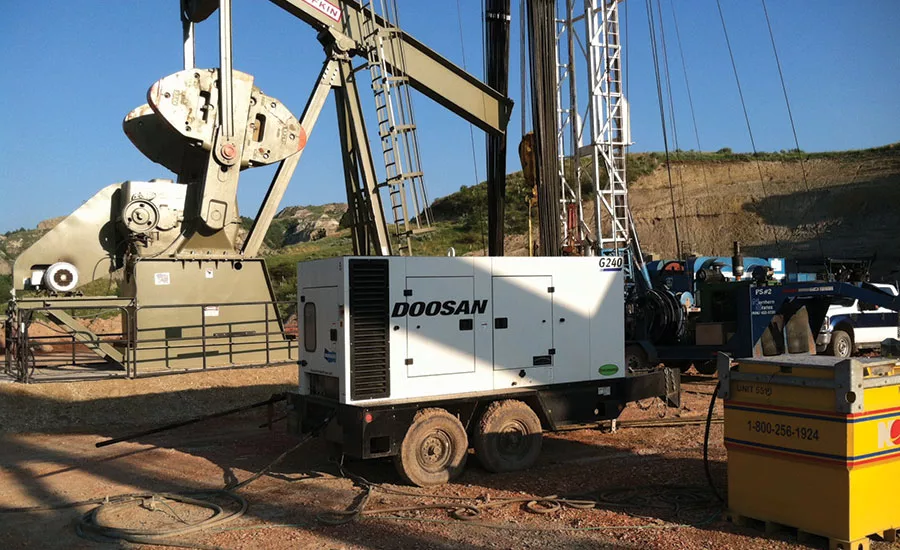What Are the Advantages of Telematics in the Oil Field?

Telematics data makes it possible to see and prevent downtime issues. Over time, that data can also illustrate usage trends that can spur more efficiency. Source: Doosan Portable Power
A mobile generator is arguably one of the most important pieces of equipment at an oil site — necessary for keeping operations running in areas where electrical grid power is nonexistent. But just having a mobile generator on site isn’t enough in an industry driven by productivity.
Oil producers and rental distributors want to know the equipment powering the operation is providing the expected performance. Machine monitoring was once a nearly impossible feat due to the remote location of most oil sites. However, advances in telematics systems are making it possible to not only monitor a mobile generator operation, but also increase revenue, decrease costs and improve service.
Increase Revenue
One of the main advantages of telematics is peace of mind that the generator is operating as intended. This is especially beneficial in the oil and gas industry, where outlying, off-grid locations are commonplace. The monitoring capability can minimize the cost associated with downtime and helps prevent situations where downtime is undetected for an extended period between site visits.
Telematics makes it possible to know almost instantly if a generator stops operating. But perhaps more importantly, it can communicate the potential for a shutdown that can then be averted. Without telematics, a generator could shut down and it may be several days before it’s discovered, resulting in huge productivity and revenue losses.
With a telematics package, machine performance can be monitored remotely through customizable data feeds that can be viewed on laptops or mobile devices. Typically, any machine diagnostics that can be read on the control panel can be communicated through a telematics system.
The frequency of data feeds varies from real time to once daily based on preference. Available data varies by telematics system but ranges from general machine operating status to alerts and warnings, as well as maintenance and fueling reminders. The cost of telematics includes a monthly fee based on the volume of data requested and frequency of communication.
The cost is also determined by whether the data can be transmitted via cellular tower or satellite signal. Generators operating in extremely remote extraction sites are unlikely to ever have access to grid power, let alone cellular towers. Thus, satellite communication may be the only viable option for receiving data downloads, increasing the overall cost of telematic data.
Decrease Cost
The top three requests for telematics data related to Doosan Portable Power generators are to monitor fuel level, running hours and the physical location of equipment. This data can provide a major time and cost benefit by reducing the need for frequent visits to the machine. Telematics data can replace the traditional method of scheduling service intervals and fuel truck delivery based on estimated operating hours and predicted fuel consumption.
For instance, a pump jack running 24/7 at 80 percent utilization will accrue 6,000 hours of operation. That would require 12 service maintenance intervals — one each month. However, if a machine has been offline for an extended period and a technician arrives for an oil change, it may be a wasted trip. The same scenario applies to fuel delivery. The accurate, timely reporting of running hours and fuel levels through telematics allows for more effective planning of service and fuel refills, eliminating extra time and cost of unnecessary travel to the generator site.
Improve Service
Telematics can provide significant cost reductions in terms of service efficiency as well. In the past, a technician would be deployed to a jobsite to service a generator with no idea what may be causing the machine to malfunction. The lack of information often led to repeat trips for necessary tools or parts, delaying repairs further.
With telematics data — particularly alerts and warnings — a service technician can gain diagnostic insight and arrive on site with the appropriate tools and parts to make the repairs, minimizing downtime and getting the machine back up and operating as quickly as possible.
Telematics data may also be able to uncover trends in machine operations that can lead to better utilization. If a technician is noticing recurring issues or alerts because the machine is being operated underload, the data can be reviewed to determine if a solution exists. In some instances, a smaller size generator will provide the necessary power with better fuel economy, and in turn, fewer service issues.
Telematics data makes it possible to proactively manage productivity and achieve operational efficiency in the oil fields. The total cost of adding a telematics system should be weighed against the potential value to the business overall — increased revenue, decreased overhead and improved service.
Looking for a reprint of this article?
From high-res PDFs to custom plaques, order your copy today!




